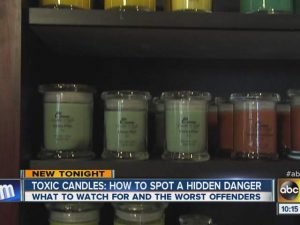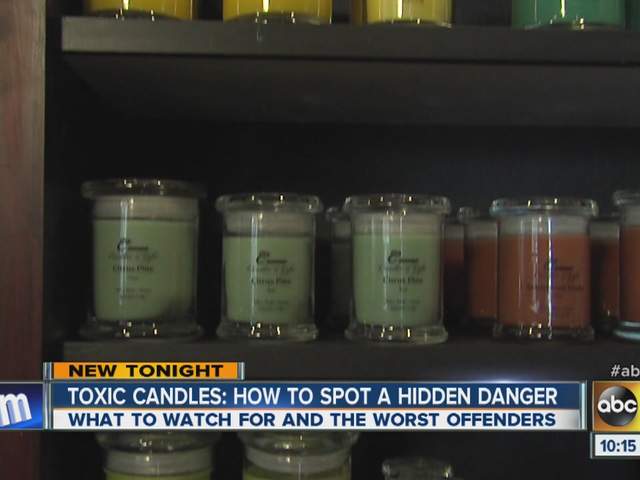 Everyone loves a wonderfully smelling candle. Our favorite scent can bring back memories of a summer’s day, a cozy campfire or even our favorite fruit.
Everyone loves a wonderfully smelling candle. Our favorite scent can bring back memories of a summer’s day, a cozy campfire or even our favorite fruit.
The warm glow from the flame can create a comfortable atmosphere that you never want to leave.
But what if you knew that all of those sensations came at a price—one that might be costing you your health?
While these scents evoke a feeling of nostalgia, those beautifully scented candles may be not be worth the health risks that come with burning them.
Ingredients in Scented Candles
Paraffin Wax
Let’s start by looking at the ingredients. Candles release what is known as volatile organic compounds (VOCs) before and after they are lit. Not all of these VOCs are classified as toxic or dangerous, but there are a few that are noteworthy. It all begins with the largest component of the candle—the base ingredient.
The most common base for candles is paraffin wax. Paraffin wax began as a cost-effective alternative to using beeswax because the supply was so great. Unfortunately, paraffin is the leftover residue from the process of refining gasoline and motor oils.
When it is burned, it releases particles into the air known as paraffin soot. These particles are similar to those released when diesel fuel is burned. This isn’t exactly something you want you or your loved ones inhaling.
Benzene
One study found that a variety of carcinogens are released from paraffin-based candles both while lit and not lit. Two well-known toxicants that are released when paraffin wax is burned are benzene and toluene.
Benzene is one of the aromatic elements of a candle as it provides a sweet smell when it is released, but it is also classified as a known human carcinogen.
Breathing in high levels of this chemical has been known to cause drowsiness, dizziness, heartbeat irregularities and headaches. Long-term exposure of benzene has also been shown to cause menstrual irregularities amongst women as well as have carcinogenic effects.
Toluene
Toluene has an interesting effect on the human body. At certain levels, it can not only cause headaches and dizziness, but it can also result in a feeling of intoxication. Studies have shown that this particular chemical is sometimes used to invoke intoxication amongst solvent abusers.
While that’s probably not the intent of most, if not all, women wanting to enjoy a scented candle, it can still result in the uncomfortable feelings of eye and lung irritation at low levels of inhalation.
Formaldehyde
Another hazardous chemical released is formaldehyde. While many people may think of formaldehyde as a preserving agent for cadavers and other scientific projects, this compound is found a variety of things.
Surprisingly, it was found to be one of the most released chemicals from all lit candles tested in a study performed in 2015.
Formaldehyde has been classified as a known human carcinogen, and short-term exposure has been known to cause skin, eye, nose and throat irritation. Those with asthma may be particularly susceptible to irritation from formaldehyde.
Other Ingredients
Several other ingredients include styrene, acetone, xylenes and isobutyl alcohol. These ingredients can have potentially harmful side-effects. Styrene has been classified as possibly carcinogenic while acetone, xylenes and isobutyl alcohol are all known skin, eye, nose, throat and lung irritants.
Acetone has been shown to produce greater toxicity in children (yikes for the little ones in the house!), and xylenes and isobutyl alcohol along with acetone have been found in a variety of toxic chemicals including gasolines, paints, paint thinners and varnishes!
Candle Wicks
As if the ingredients in the wax itself weren’t bad enough, the ingredients in metal-core wicks may also present a health risk. In 2000, a study of a variety of candle brands revealed many of them released lead and zinc into the air from the wick.
Some of those candles only needed to burn for two hours before the amount of airborne lead became hazardous to human health!
Because of this and other studies, the United States placed a ban on using lead in metal-core wicks in 2003. Unfortunately, zinc has become the norm for metal-based wicks today, but not without its own adverse side-effects.
Zinc is an essential mineral for cell function in the human body, but exposure to an excessive amount of zinc can have significant health consequences, particularly involving the kidneys.
Non-toxic Alternatives
So what are the alternatives to these hazardous candles? How can we take one more step to be sure that the air quality in our homes is as clean and beneficial to our bodies as possible?
One of the go-to natural waxes for candles is beeswax. As mentioned earlier, it was used well before paraffin to make candles. It is important, however, when choosing a beeswax candle to find one that is high-quality as bees can inadvertently collect heavy-metal contaminants, especially if they live near urban areas, which can be released into the air when the candle is burned.
Make sure you read the labels to guarantee that your candle is 100% beeswax instead of a blend of beeswax and paraffin.
Soy candles have also gained popularity, but just like beeswax candles, some may contain paraffin so make sure your candles are of the highest quality by reading the labels and ingredients from the manufacturer. Also, be aware that any added scents, if not from essential oils or other natural ingredients, could release toxic chemicals into the air when lit.
It is also important to note that the majority of soy in the United States has been genetically modified which may change the properties when it is burned as a candle.
Other ways to create non-toxic aromas for the home include properly diffusing essential oils, creating an essential oil house spray or even simmering a blend of fruits and spices on the stove. All of these, when done appropriately, can create an inviting, sophisticated atmosphere in any home!
All the toxins in the candles are also often use in many products.
It is important to protect yourself from detrimental effects of these toxins – who knows what can lead to cancer or other diseases?
Go to the next page and learn about a powerful nutrient that many proven drugs like Penicillin, Cyclosporin and Krestin have replicated after that can protect your body from these toxins –
About the Author:
Emma Deangela is the best selling author of The Alkaline Diet Program and 80/20 Fat Loss. She has helped over tens of thousands of men and women to lose weight and transform their health with sound nutrition advice. Learn how you can lose weight fast – How to lose weight by adding these alkaline foods.
Do you love scented candles? Share with us what candles do you use.
Please share with your friends this scented candle article using any of the social media and email buttons on the left of our website.


Leave a Reply